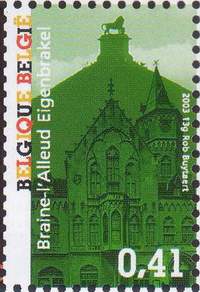Manifestations (préventes, bourses, etc...)
Exposition internationale et bureau temporaire Braphil '15
KING Chris Royal Philatelic Society London
DENMARK AND THE NAPOLEONIC WARS
7th November 1806, N° 23 GRANDE ARMEE entire letter sent from Lübeck to Douai in the Department de Nord. Marked 7 (Decimes)
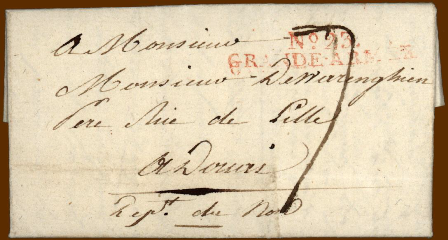 Eye witness account of the battle of Lübeck – Murat, Bernadotte and Soult in battle against Blücher
Eye witness account of the battle of Lübeck – Murat, Bernadotte and Soult in battle against Blücher
Listed by De Frank as not yet seen (1948) and by Reinhardt only in 1807 (1986)
Lubeck, 7 November 1806
My dear Father,
The campaign against the Prussians has ended very happily, and all the Prussian forces have been destroyed. The battalion of Marshal Bluker, which we have beaten at Gabel and at Lubeck, has surrendered completely; it was the only battalion, which still had not yet capitulated.
Lubeck township was entered yesterday in strength by the army commanded by Marshal Bernadotte. The 20,000 Prussians, who had defended it, have been hunted and have suffered a crushing defeat. We took 5000 prisoners and captured 25 canons. Prince Murat pursued the enemy with his cavalry, and has forced them to surrender today.
1200 Swedes, who were at Lubeck, have been forced to surrender when they were about to sail. The tide then low, did not allow them to approach close to the edge of the canal where we were, and the small number of boats, which could be used, made disembarkation very slow. Meanwhile, the Prussians, who occupied the other bank, realising the capitulation, brought up six canons with infantry and cavalry and fired murderously on those Swedes, who were disembarking without surrendering. Our artillery replied to the Prussian artillery and succeeded in silencing the Prussians. The Swedes had many killed and wounded, and the rest had been taken prisoner.
We can see that we are going to restart the war against the Prussians. I hope that we will have at least several days rest as they are well needed after the greatly tiring time, which we have endured.
I have spoken of General Lahure to Prince Bernadotte, who asked me to compliment him well. Please give my brothers and sisters my love and be assured of my respectful attachment. de Warenghien
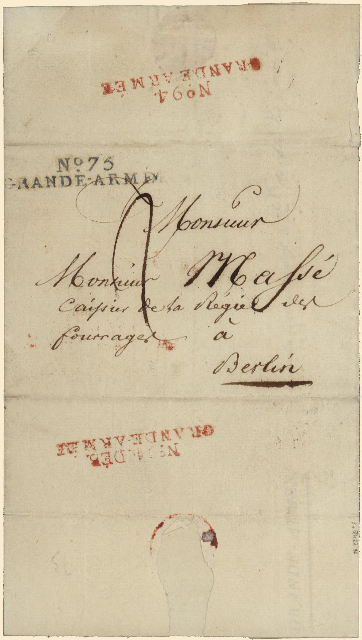 5th May 1808, N° 75 GRANDE ARMÉE entire letter sent from Odense on the Island of Fyn in Denmark. Carried via Hamburg,
N° 94 GRANDE ARMÉE, and forwarded with N° 94 DÉB GRANDE ARMÉE to Berlin.
5th May 1808, N° 75 GRANDE ARMÉE entire letter sent from Odense on the Island of Fyn in Denmark. Carried via Hamburg,
N° 94 GRANDE ARMÉE, and forwarded with N° 94 DÉB GRANDE ARMÉE to Berlin.
Only one other letter is recorded from General Romagna’s Spanish army in Denmark.
In 1807 Spain sent an expeditionary force from the regular Spanish Army to Northern Europe, to serve with the French Grande Armée. The expeditionary force, the Division of the North, was commanded by Marquis de la Romana and consisted of four regiments of line infantry, five regiments of cavalry, two battalions of light infantry, and supporting artillery. The Spanish expeditionary force participated in the siege of the Swedish fortress of Stralsund in late 1807. The armies were then broken up and stationed in different parts of Denmark.
The Spanish expeditionary force was still in Denmark in the summer of 1808, when news of events in Spain arrived. The Bourbons of Spain had been forced to abdicate and Napoleon proclaimed his brother, Joseph Bonaparte, as King of Spain on 6th June 1808.
The crowning of Joseph Bonaparte was considered by many in the Spanish expeditionary force as disgraceful. They were too far from home and too close to French forces to do anything about the situation in Spain. However, a British agent contacted the Marquis de la Romana, and offered him passage to Spain on British ships.
He accepted, and on 11th August 1808 the Spanish seized the port of Nyborg on the Danish island of Fyn. About two-thirds of the army, around 9000 men, sailed to La Coruña. However, not all of the units of the Spanish expeditionary force made a successful embarkation. The Asturias and Guadalaxara infantry regiments were overwhelmed, disarmed and captured by French and Danish forces. The Algarve cavalry regiment, the furthest unit from Nyborg, did not attempt to escape and actually revealed the escape plot to the French. A total of over 3,500 Spanish troops become prisoners of war.

25th February 1817, Entire letter from the danske Armeecorps sent from Lens in France to Oldesloe in Holstein. Karte number 6 on reverse with 13 Skilling to be paid, and 4 on front, being the postage paid.
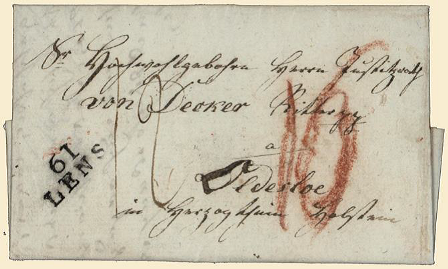
17th November 1816, Entire letter from the danske Armeecorps sent from Lens in France to Oldesloe in Holstein. Handstamped LENS 61 (Napoleonic Department 61, Pas-de-Calais, created 1790) Karte number 8 on reverse with 51 Skilling to be paid, and 16 on front, being the postage paid.
The Danish Army Corps 1816-1818.
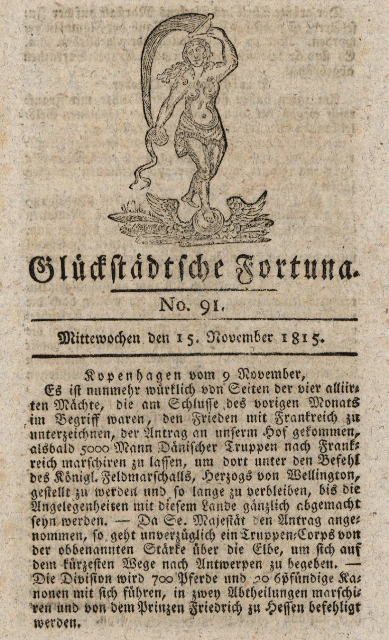 In the Treaty of Paris signed on 20th November 1815, following the defeat and second abdication of Napoleon Bonaparte, article V made clear the allies' determination to maintain peace. They agreed to set up a multinational occupation force of 150,000 men to be positioned along France's north-eastern frontier between Calais and Switzerland. They were not to be used to police or administer France, nor were they to interfere with the king's authority. They were expected to remain five years, but the allies promised to review the position after three.
In the Treaty of Paris signed on 20th November 1815, following the defeat and second abdication of Napoleon Bonaparte, article V made clear the allies' determination to maintain peace. They agreed to set up a multinational occupation force of 150,000 men to be positioned along France's north-eastern frontier between Calais and Switzerland. They were not to be used to police or administer France, nor were they to interfere with the king's authority. They were expected to remain five years, but the allies promised to review the position after three.
The allied sovereigns were to choose the commander, and each of them was to provide 30,000 men, including infantry, cavalry, and artillery units. Additionally, Bavaria was expected to contribute 10,000 men, while Denmark, Saxony, Hanover, and Württemberg each provided 5,000. The French government was to maintain these troops, supplying their lodging, forage, provisions, and 50 million francs annually for their equipment, pay, and clothing. The Duke of Wellington was selected for overall command.
In November 1815, the Danish Armékontigent was created. In late January 1816 the Danish troops came to northern France, where their headquarters was set up in the small French town of Lewarde – midway between the towns Bouchain and Douai. The soldiers were accommodated in the surrounding villages. The Corps was in France until the autumn of 1818, when it marched back to Denmark and was dissolved on 14th December 1818.

